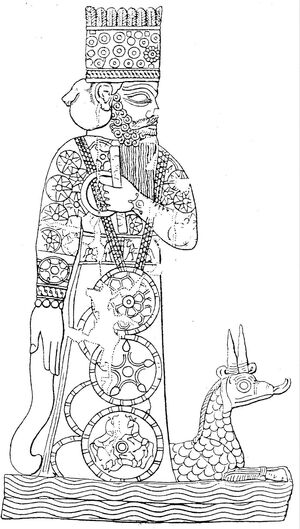Marduk, in Mesopotamian religion, was the chief god of the city of Babylon and the national god of Babylonia; as such he was eventually called simply Bel, or Lord. Originally he seems to have been a god of thunderstorms. A poem, known as Enuma elish and dating from the reign of Nebuchadrezzar I (1124–03 bc), relates Marduk’s rise to such preeminence that he was the god of 50 names, each one that of a deity or of a divine attribute. After conquering the monster of primeval chaos, Tiamat, he became Lord of the Gods of Heaven and Earth. All nature, including man, owed its existence to him; the destiny of kingdoms and subjects was in his hands.
Marduk’s star was Jupiter, and his sacred animals were horses, dogs, and especially the so-called dragon with forked tongue, representations of which adorn his city’s walls. On the oldest monuments Marduk is represented holding a triangular spade or hoe, interpreted as an emblem of fertility and vegetation. He is also pictured walking or in his war chariot. Typically, his tunic is adorned with stars; in his hand is a sceptre, and he carries a bow, spear, net, or thunderbolt.
Marduk was later known as Bel, a name derived from the Semitic word baal, or “lord.” Bel had all the attributes of Marduk, and his status and cult were much the same. Bel, however, gradually came to be thought of as the god of order and destiny. In Greek writings references to Bel indicate this Babylonian deity and not the Syrian god of Palmyra of the same name.
He is known throughout Mesopotamian mythology as the god that slew Tiamat. He used half of her body to create the roof of the sky while the Tigris and the Euphrates emerged from her eyes, and mountains from her udders.
In Babylonian mythology, Tiamat is a monster of chaos, a primordial goddess of the ocean, mating with Abzû (the god of fresh water) to produce younger gods. It is suggested that there are two parts to the Tiamat mythos, the first in which Tiamat is 'creatrix', through a "Sacred marriage" between salt and fresh water, peacefully creating the cosmos through successive generations. In the second "Chaoskampf" Tiamat is considered the monstrous embodiment of primordial chaos. This shift in cosmological metaphors has been linked to the rise of Patriarchal power structures and the assumption of power by the monarchial "lugal" (Lu = Man, Gal = Big), during the Early Dynastic period of Sumerian History, and the institutionalisation of warfare. Although there are no early precedents for it, some sources identify her with images of a sea serpent or dragon. In the Enûma Elish, the Babylonian epic of creation, she gives birth to the first generation of deities; she later makes war upon them and is killed by the storm-god Marduk. The heavens and the earth are formed from her divided body.
